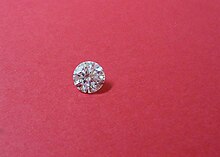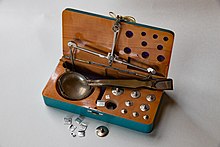Carat (mass)
| carat | |
|---|---|
 | |
| General information | |
| Symbol | ct |
| Conversions | |
| 1 ct in ... | ... is equal to ... |
| milligrams | 200 |
| Conversions (imperial) | |
| 1 imp ct in ... | ... is equal to ... |
| ounces | 0.00705 |
| Part of a series on |
| Diamonds |
|---|
 |
| Material |
| The 4 Cs |
| Production |
| Cultural impact |
| Imitations and enhancements |
| Theft |

The carat (ct) is a unit of mass equal to 200 mg (0.00705 oz; 0.00643 ozt), which is used for measuring gemstones and pearls. The current definition, sometimes known as the metric carat, was adopted in 1907 at the Fourth General Conference on Weights and Measures,[1][2] and soon afterwards in many countries around the world.[i] The carat is divisible into 100 points of 2 mg. Other subdivisions, and slightly different mass values, have been used in the past in different locations.
In terms of diamonds, a paragon is a flawless stone of at least 100 carats (20 g).[3]
The ANSI X.12 EDI standard abbreviation for the carat is CD.[4]
Etymology
[edit]First attested in English in the mid-15th century, the word carat comes from Italian carato, which comes from Arabic (qīrāṭ; قيراط), in turn borrowed from Greek kerátion κεράτιον 'carob seed',[5][6][7] a diminutive of keras 'horn'.[8] It was a unit of weight, equal to 1/1728 (1/123) of a pound (see Mina (unit)).[6][9][5]
History
[edit]Carob seeds have been used throughout history to measure jewelry, because it was believed that there was little variance in their mass distribution.[10] However, this was a factual inaccuracy, as their mass varies about as much as seeds of other species.[11]
In the past, each country had its own carat. It was often used for weighing gold. Beginning in the 1570s, it was used to measure weights of diamonds.[5]
Standardization
[edit]An 'international carat' of 205 milligrams was proposed in 1871 by the Syndical Chamber of Jewellers, etc., in Paris, and accepted in 1877 by the Syndical Chamber of Diamond Merchants in Paris. A metric carat of 200 milligrams – exactly one-fifth of a gram – had often been suggested in various countries,[2] and was finally proposed by the International Committee of Weights and Measures, and unanimously accepted[2] at the fourth sexennial General Conference of the Metric Convention held in Paris in October 1907. It was soon made compulsory by law in France, but uptake of the new carat was slower in England, where its use was allowed by the Weights and Measures (Metric System) Act of 1897.[12]
Historical definitions
[edit]| Location | mg |
|---|---|
| Cyprus | 187 |
| unknown | 188.6 |
| Brazil | 192.2 |
| Egypt | 195 |
| Ambonia | 197 |
| Florence | 197.2 |
| International carat Batavia, Borneo, Leipzig |
205 |
| South Africa (1) | 205.304 |
| London-New York (1) | 205.303 |
| Spain | 205.393 |
| London-New York (2) | 205.409 |
| Berlin | 205.44 |
| Paris, East India | 205.5 |
| South Africa (2) | 205.649 |
| Amsterdam | 205.7 |
| Lisbon | 205.75 |
| Frankfurt (on Main) | 205.77 |
| Vienna | 206.13 |
| Venice | 207 |
| Madras | 207.353 |
| unknown | 213 |
| Bucharest | 215 |
| Livorno | 215.99 |
UK Board of Trade
[edit]In the United Kingdom the original Board of Trade carat was exactly 3+1647⁄9691 grains (~3.170 grains = ~205 mg);[ii] in 1888, the Board of Trade carat was changed to exactly 3+17⁄101 grains (~3.168 grains = ~205 mg).[iii] Despite it being a non-metric unit, a number of metric countries have used this unit for its limited range of application.
The Board of Trade carat was divisible into four diamond grains,[iv] but measurements were typically made in multiples of +1⁄64 carat.
Refiners' carats
[edit]There were also two varieties of refiners' carats once used in the United Kingdom—the pound carat and the ounce carat.[v] The pound troy was divisible into 24 pound carats of 240 grains troy each; the pound carat was divisible into four pound grains of 60 grains troy each; and the pound grain was divisible into four pound quarters of 15 grains troy each. Likewise, the ounce troy was divisible into 24 ounce carats of 20 grains troy each; the ounce carat was divisible into four ounce grains of 5 grains troy each; and the ounce grain was divisible into four ounce quarters of 1+1⁄4 grains troy each.[14]
Greco-Roman
[edit]The solidus was also a Roman weight unit. There is literary evidence that the weight of 72 coins of the type called solidus was exactly 1 Roman pound, and that the weight of 1 solidus was 24 siliquae. The weight of a Roman pound is generally believed to have been 327.45 g or possibly up to 5 g less. Therefore, the metric equivalent of 1 siliqua was approximately 189 mg. The Greeks had a similar unit of the same value.[15]
Gold fineness in carats comes from carats and grains of gold in a solidus of coin. The conversion rates 1 solidus = 24 carats, 1 carat = 4 grains still stand.[16] Woolhouse's Measures, Weights and Moneys of All Nations[17] gives gold fineness in carats of 4 grains, and silver in troy pounds[17] of 12 troy ounces of 20 pennyweight each.[clarification needed]
Notes
[edit]- ^ The United States adopted the metric carat definition on July 1, 1913, the United Kingdom on 1 April 1914.
- ^ The pre-1888 Board of Trade carat, of which there were exactly 151+27⁄64 per ounce troy, was approximately 205.4094 mg (3.169951 gr).
- ^ The post-1887 Board of Trade carat, of which there were exactly 151+1⁄2; per ounce troy, was approximately 205.3035 mg (3.168317 gr).
- ^ Unlike the modern carat, the Board of Trade carat was not used for measuring pearls; those were measured with pearl grains.
- ^ The refiners' carats were the offspring of the carat as a measure of fineness for gold.
References
[edit]- ^ Science. American Association for the Advancement of Science. 1908. p. 144. Retrieved 30 June 2012.
- ^ a b c Comptes rendus des séances de la quatrième conférence générale des poids et mesures, 1907, page 89
- ^ American Heritage Dictionary of the English Language. Houghton Mifflin Harcourt. 2013. Archived from the original on 2016-08-09. Retrieved 2013-12-24.
- ^ "ANSI Units of Measure" (PDF). das.ct.gov. Dept. of Admin. Services, State of Connecticut. Archived from the original (PDF) on April 17, 2012.
- ^ a b c Harper, Douglas. "carat". Online Etymology Dictionary.
- ^ a b Liddell, Henry George; Scott, Robert. "κεράτιον". A Greek-English Lexicon – via Perseus.Tufts.edu.
- ^ Skeat, Walter W. (1888). "carat". An Etymological Dictionary of the English Language. London: Henry Frowde. pp. 93–94.
- ^ Liddell, Henry George; Scott, Robert. "κέρας". A Greek-English Lexicon – via Perseus.Tufts.edu.
- ^ "carat". Oxford Dictionaries. Archived from the original on August 24, 2010 – via oxforddictionaries.com.
- ^ Naturski, Sebastian. "Carat Weight". Your Diamond Teacher. Retrieved 3 March 2017.
- ^ Turnbull, L. A.; Santamaria, L.; Martorell, T.; Rallo, J.; Hector, A. (2006). "Seed size variability: From carob to carats". Biology Letters. 2 (3): 397–400. doi:10.1098/rsbl.2006.0476. PMC 1686184. PMID 17148413.
- ^
 One or more of the preceding sentences incorporates text from this source, which is in the public domain: Leonard J. Spencer (1910). "Notes on the weight of the 'Cullinan' diamond". Mineralogical Magazine. Vol. XV, no. 71. pp. 318–326.
One or more of the preceding sentences incorporates text from this source, which is in the public domain: Leonard J. Spencer (1910). "Notes on the weight of the 'Cullinan' diamond". Mineralogical Magazine. Vol. XV, no. 71. pp. 318–326.
- ^ Zhengzhang, Tao (July 1991). "On the origin of the carat as the unit of weight for gemstones". Chinese Journal of Geochemistry. 10 (3): 288–293. doi:10.1007/BF02843332. ISSN 1993-0364. S2CID 127800966.
- ^ Chaffers, William (1883). Hall Marks on Gold and Silver Plate (6th ed.). London: Bickers & Son.
- ^ Grierson, Philip (1960). "The Monetary Reforms of 'Abd Al-Malik". Journal of the Economic and Social History of the Orient. 3 (3): 241–264. doi:10.1163/156852060X00098.
- ^ Harper, K (2016). "People, Plagues, and Prices in the Roman World: The Evidence from Egypt". The Journal of Economic History. 76 (3). Cambridge University: 803–839. doi:10.1017/S0022050716000826. Retrieved 16 June 2019.
- ^ a b Woolhouse, W. S. B. (1891). Measures, Weights and Moneys of All Nations.
